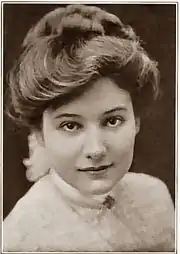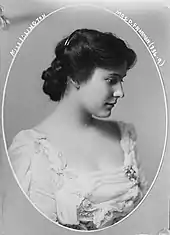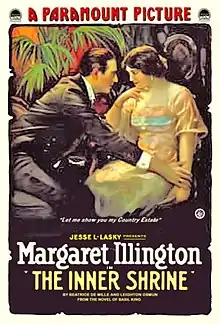Margaret Illington
Margaret Illington (born Maude Light; July 23, 1879 – March 11, 1934) was an American stage actress popular in the first decade of the 20th century. She later made an attempt at silent film acting by making two films with Adolph Zukor's Famous Players-Lasky franchise.
Margaret Illington | |
|---|---|
 Illington featured in Theatre Magazine, 1906 | |
| Born | Maude Light July 23, 1879 Bloomington, Illinois, U.S. |
| Died | March 11, 1934 (aged 54) Miami Beach, Florida, U.S. |
| Resting place | Sleepy Hollow Cemetery[1] |
| Other names | Margaret Illington Bowes |
| Occupation | Actress |
| Years active | 1900–1919 |
| Spouse(s) | |
Biography
Maude Light was born on July 23, 1879 in Bloomington, Illinois to I.H. Light and his wife, Mary Ellen. She was educated at Illinois Wesleyan University and then for two years was a pupil at Conway's Dramatic School in Chicago.[2]
She made her Broadway debut in 1900 and a few years later she married Broadway impresario Daniel Frohman in 1903 making her a sister-in-law of powerful theater owner Charles Frohman. The marriage didn't last the decade and ended in 1909 but her association with Frohman was a tremendous boost to her career. An early Broadway success was The Two Orphans, 1904, co-starring Grace George. She and George played the sisters later played famously by Lillian and Dorothy Gish in D. W. Griffith's 1921 film Orphans of the Storm.[3][4]


Illington married Edward Bowes in 1910 and desired to have a baby according to newspaper accounts that interviewed her.[5] But it was not to be and she continued in plays. One of her best known plays at this time was Kindling later turned into a 1916 silent film by Cecil B. DeMille, but minus Illington. In 1917 Illington decided to try her hand at moviemaking and signed with Adolph Zukor and Jesse Lasky.[6] She starred in The Inner Shrine and Sacrifice, both directed by stage actor Frank Reicher. Zukor famously visited her on the set during the making of The Inner Shrine.[7] When her two films were completed she returned to the stage and remained for about two years before retiring in 1919.[8]
In 1906 she was painted by the Swiss-born American society painter Adolfo Müller-Ury, a three-quarter seated portrait wearing a gown from the play "Mrs Leffingwall's Boots", which was exhibited at the gallery of M. Knoedler & Co., Fifth Avenue that December. Müller-Ury sent the picture to the Paris Salon in 1907 (No. 1191), and exhibited it three times more in 1908 in New York, Washington and Philadelphia. It was reproduced in The Metropolitan Magazine, Vol. XXV, No. 1, 5 October 1906. She died in Miami, Florida in 1934.
References
- Margaret Illington profile, Findagrave.com; accessed March 31, 2014.
- Parker, John; compiler (1976). Who Was Who in the Theatre: 1912-1976. Gale Research, 1976.
- "MARGARET ILLINGTON ILL; Has Been Off the Stage Since Friday--Suffering from Overexertion", The New York Times, December 3, 1907.
- "DANIEL FROHMAN SUED FOR DIVORCE; Margaret Illington Accuses the Theatrical Manager of Desertion. SHE TIRED OF THE STAGE Wanted a Domestic Life and Children--Denies She Will Wed Again-Suit Brought in Nevada", The New York Times, October 19, 1909.
- "MARGARET ILLINGTON WEDS NEW HUSBAND; Actress Divorced Last Week from Daniel Frohman Now Wife of Edward J. Bowes. MARRIAGE OCCURS AT RENO But Judge Who Granted Divorce Refused to Tie New Knot – Pair Start for Their Home in Tacoma", The New York Times, November 15, 1909.
- "Margaret Illington A Lasky Star", The Moving Picture World, January 13, 1917 p.203.
- Blum, Daniel (1953). Pictorial History of the Silent Screen, page 130.
- Boardman, Gerald (1992). The Oxford Companion to the American Theatre. Second edition, 1992.
External links
| Wikimedia Commons has media related to Margaret Illington. |
| Wikisource has the text of a 1921 Collier's Encyclopedia article about Margaret Illington. |